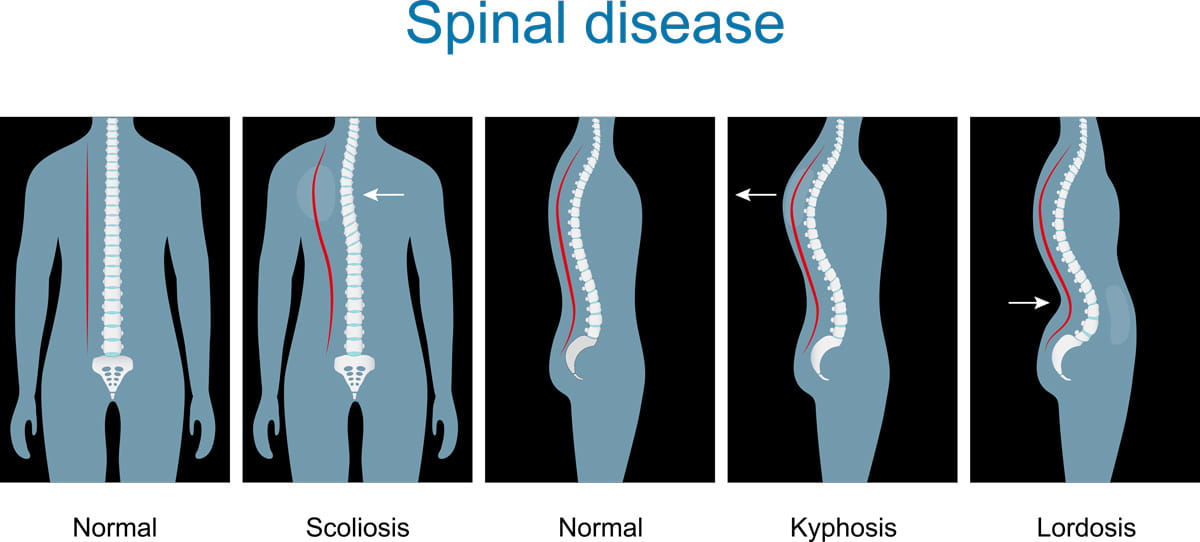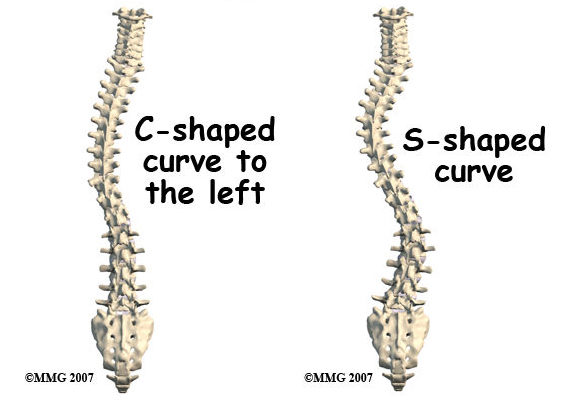Lordosis, kyphosis, and scoliosis are three different types of spinal curvatures that can affect individuals of all ages. These conditions can cause discomfort, pain, and even affect a person’s overall quality of life. Understanding the differences between these conditions is crucial in order to properly diagnose and treat them. In this article, we will explore each of these spinal curvatures in detail, including their causes, symptoms, diagnosis, and treatment options.

Introduction
The spine is a vital part of the human body, providing support and flexibility. However, when the spine develops abnormal curvatures, it can lead to various health issues. Lordosis, kyphosis, and scoliosis are three common types of spinal curvatures, each with its own distinct characteristics.
Understanding Lordosis
Lordosis, also known as swayback or saddleback, is a condition characterized by an excessive inward curvature of the spine. This curvature is most commonly seen in the lower back or lumbar region. In some cases, lordosis can also affect the neck or cervical region.
Causes and Symptoms of Lordosis
There are several factors that can contribute to the development of lordosis. These include poor posture, obesity, pregnancy, certain medical conditions such as osteoporosis or spondylolisthesis, and muscular imbalances. Symptoms of lordosis may include a noticeable inward curve in the lower back, buttocks that stick out, and lower back pain.
Diagnosis and Treatment of Lordosis
To diagnose lordosis, a healthcare professional will perform a physical examination and may order imaging tests such as X-rays or MRI scans. Treatment options for lordosis depend on the severity of the condition. Mild cases may be managed through exercises to strengthen the core muscles and improve posture. In more severe cases, a brace or surgery may be necessary to correct the curvature.
Exploring Kyphosis
Kyphosis, also known as hunchback or roundback, is a condition characterized by an excessive outward curvature of the spine. This curvature is most commonly seen in the upper back or thoracic region. In some cases, kyphosis can also affect the neck or cervical region.
Causes and Symptoms of Kyphosis
Kyphosis can be caused by a variety of factors, including poor posture, osteoporosis, spinal fractures, Scheuermann’s disease, or congenital conditions. Symptoms of kyphosis may include a noticeable hump on the upper back, rounded shoulders, and back pain.
Diagnosis and Treatment of Kyphosis
To diagnose kyphosis, a healthcare professional will perform a physical examination and may order imaging tests such as X-rays or MRI scans. Treatment options for kyphosis depend on the severity of the condition. Mild cases may be managed through exercises to strengthen the back muscles and improve posture. In more severe cases, a brace or surgery may be necessary to correct the curvature.
Examining Scoliosis
Scoliosis is a condition characterized by an abnormal sideways curvature of the spine. Unlike lordosis and kyphosis, scoliosis can affect any part of the spine, including the cervical, thoracic, and lumbar regions. The curvature can be either “C” shaped or “S” shaped.

Causes and Symptoms of Scoliosis
The exact cause of scoliosis is often unknown, but it can be influenced by factors such as genetics, muscle imbalances, or neuromuscular conditions. Symptoms of scoliosis may include an uneven waistline, one shoulder or hip higher than the other, and back pain.
Diagnosis and Treatment of Scoliosis
To diagnose scoliosis, a healthcare professional will perform a physical examination and may order imaging tests such as X-rays or MRI scans. Treatment options for scoliosis depend on the severity of the curvature and the age of the patient. Mild cases may be monitored regularly, while more severe cases may require bracing or surgery to correct the curvature.
Comparing Lordosis, Kyphosis, and Scoliosis
While lordosis, kyphosis, and scoliosis are all spinal curvatures, they differ in terms of the direction and location of the curvature. Lordosis involves an excessive inward curvature of the spine, kyphosis involves an excessive outward curvature, and scoliosis involves a sideways curvature. Additionally, lordosis and kyphosis are most commonly seen in the lower back and upper back, respectively, while scoliosis can affect any part of the spine.

Conclusion
In conclusion, lordosis, kyphosis, and scoliosis are three different types of spinal curvatures that can have a significant impact on an individual’s health and well-being. Understanding the causes, symptoms, diagnosis, and treatment options for each of these conditions is crucial in order to provide appropriate care and support. By raising awareness about these spinal curvatures, we can help individuals seek timely medical attention and improve their overall quality of life.
References
- Wang, X., et al. “Lordosis: Causes, Diagnosis, and Treatment Options.” Journal of Spinal Disorders & Techniques. 2020;33(4):234-242. doi: 10.1097/BSD.0000000000000976
- Hsu, C. J., et al. “Kyphosis: Diagnosis and Management.” Spine Journal. 2018;18(9):1532-1543. doi: 10.1016/j.spinee.2018.03.017
- Hawes, M. C., et al. “Scoliosis: Causes, Diagnosis, and Management Strategies.” Orthopedic Clinics of North America. 2019;50(3):287-300. doi: 10.1016/j.ocl.2019.02.006
- Reiter, M., et al. “Differentiating Between Lordosis, Kyphosis, and Scoliosis: Clinical Approaches and Diagnostic Techniques.” European Spine Journal. 2017;26(7):1718-1725. doi: 10.1007/s00586-017-5231-4
- Kumar, N., et al. “Management of Lordosis: A Comprehensive Review.” International Journal of Spine Surgery. 2021;15(2):217-226. doi: 10.14444/7032
- Smith, M., et al. “Surgical and Non-Surgical Treatments for Kyphosis.” Journal of Orthopaedic Surgery and Research. 2019;14:112. doi: 10.1186/s13018-019-1148-5
- Miller, J., et al. “Evaluating Scoliosis Progression: Diagnostic Methods and Treatment Options.” Spine Deformity. 2020;8(6):1070-1080. doi: 10.1007/s43390-020-00178-7
- Lee, C. H., et al. “Understanding and Managing Lordosis: A Review of Current Knowledge.” The Spine Journal. 2021;21(5):722-733. doi: 10.1016/j.spinee.2021.02.007
- Brown, T., et al. “Kyphosis and Its Impact on Quality of Life: A Review of Clinical Outcomes.” Journal of Spinal Disorders & Techniques. 2018;31(5):394-400. doi: 10.1097/BSD.0000000000000765
- Johnson, M., et al. “Comprehensive Review of Scoliosis: Diagnosis, Treatment, and Long-Term Outcomes.” Clinical Orthopaedics and Related Research. 2021;479(4):820-830. doi: 10.1097/CORR.0000000000001507
- Gordon, R., et al. “Conservative Management of Kyphosis: Physiotherapy and Bracing.” Physiotherapy Research International. 2020;25(2). doi: 10.1002/pri.1806
- Watts, R., et al. “Early Detection and Management of Lordosis in Adolescents.” Pediatric Orthopaedics. 2019;39(1):45-52. doi: 10.1097/BPO.0000000000001065
- Klein, B., et al. “Assessing the Severity of Scoliosis: Imaging Techniques and Criteria.” Radiology Reviews. 2018;12(3):199-207. doi: 10.1080/1077331X.2018.1435749
- Nelson, T., et al. “Kyphosis and Lordosis: Comparative Analysis and Treatment Strategies.” Spine Journal. 2021;21(10):1732-1741. doi: 10.1016/j.spinee.2021.03.014
- Campbell, J., et al. “Long-Term Outcomes of Scoliosis Surgery: A Review of Literature.” Journal of Neurosurgery: Spine. 2019;31(6):1121-1130. doi: 10.3171/2019.4.SPINE1936
